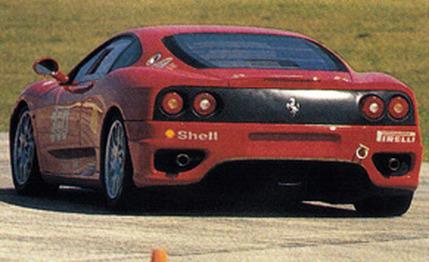
 First Drive Review
First Drive Review
The Ferrari Challenge is a racing program staged by the company for its paying customers. It gives them the chance to compete against their fellow plutocrats whilst simultaneously putting their porky wallets on the Atkins Diet. Limited to race editions of late-model cars, the Challenge series will race at eight tracks in the U.S. in 2000. Worldwide, there are five regional championship series, with global bragging rights to be settled in the fall in Mugello, Italy.
In addition to the races, Challenge weekends typically include lots of track time for local club members to flog their vintage and streetable Ferraris. "It's very important in the U.S.," says Carlo Fiorani, Ferrari's courtly press agent in this country. "Because of the strict, strict laws here, the Challenge gives U.S. owners a chance to drive the cars the proper way." Which is to say fast.
This year, 51 odiously lucky individuals, having ponied up $175,000 apiece, will field North America's allotment of the new 360 Modena Challenge car, a full-race version of the berlinetta Ferrari. For the 2000 season, Challenge races will include the 360 and the previous Challenge car, the 355, racing together, although in separate classes.
Whereas the 355 Challenge was a retrofit of the road edition that involved uprated suspension bits, a roll cage, and little else, the 360 Modena Challenge is purpose-built at the factory and includes such earnest competition gear as a 100-liter vented fuel cell, ducted brakes, and an integrated fire-suppression system. (Note to readers: For concision, we will henceforth refer to the 360 Modena Challenge car by the unofficial and wholly ad hoc designation 360MC.) From the time the all-aluminum body arrives on a truck from Carrozzeria Scaglietti, just a few miles outside Maranello, Italy, it takes the staff a month to build one (see, that was easy).
In the interest of weight saving, all traces of luxo-exotica have been scourged from the 360MC. Gone are the leather seats, carpet and upholstery, the brushed aluminum consoles, the ghoulish-green instruments. They are replaced by a single OMP racing seat, a righteous roll cage, a fire bottle where the passenger seat would be, and a simple suede-trimmed bulkhead hosting a Magneti Marelli LCD instrument panel wired with onboard telemetry.
Behind the three-spoke racing wheel reside the F1 gearbox paddles. The upshift paddle on the right has been extended an inch or so to facilitate shifting while cornering (the stick-shifted six-speed is not available in the 360MC).
Other lightening measures include skipping the sound-deadening materials, the airbags, the hand brake, air conditioning, and door and window mechanisms. The windows have been replaced by fixed Lexan panels with F40-style slide openings. Carbon fiber trims the doors. The engine cover is also Lexan.
A few vestiges of the production interior remain. The steering column is reach-and-rake adjustable; the T-shaped lever engaging reverse remains in a center console, between the big kill switch and the I-believe-I'm-on-fire button.
Ferrari claims the 360MC weighs in about 250 pounds lighter than the standard 360 Modena and more than 300 pounds lighter than the 355 Challenge car.
Compared with all the kilo-conscious belt tightening, the powertrain mods seem pretty minimal. The 3.6-liter DOHC all-aluminum V-8 remains unmolested, as it's a pretty hot mill to begin with, sporting titanium con rods, a dry sump, and an 11.0:1 compression ratio. The software controlling the Motronic ME 7.3 injection, the drive-by-wire throttle, the variable intake runners, and the exhaust-valve timing remains the same.
Among the hardware changes, the 360MC is down to one catalytic converter, and the engine sings through an open muffler, thereby eliminating the need for the variable back-pressure system -- Ferrari's urban-noise-abatement program. This change alone accounts for an increase of about four percent in horsepower, the factory says, to 410 hp. The effect is not decisive on the exhaust note, which remains warm and reedy, like the 355 played through a trumpeter's mute.